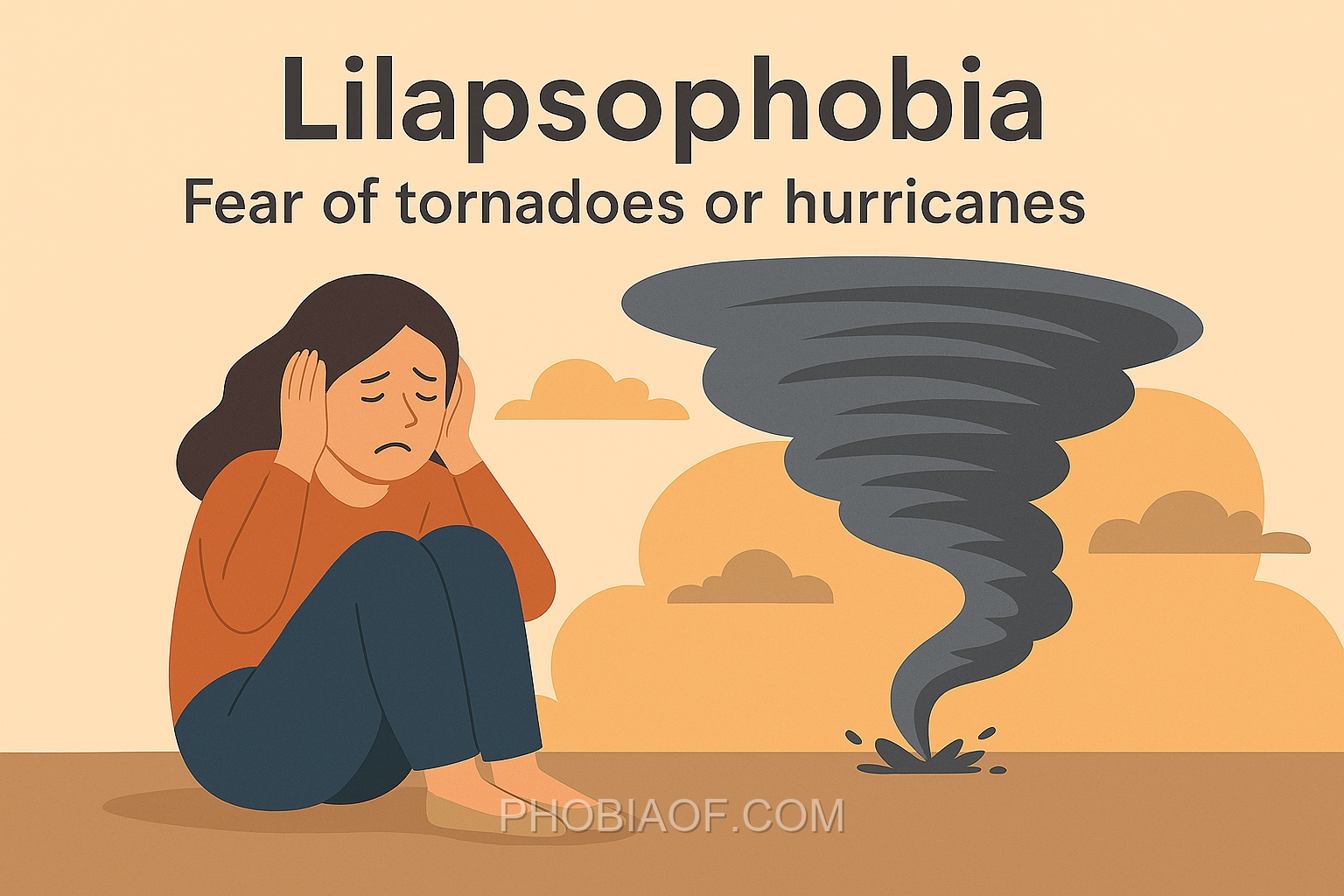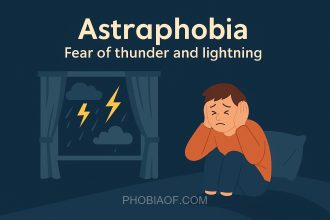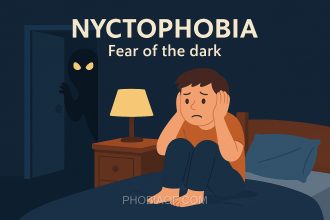Have you ever felt a chill run down your spine at the mere thought of a tornado or hurricane roaring towards you, even when the skies are clear? If so, you’re not alone. This intense fear is known as Lilapsophobia, a term derived from the Greek words “lilaps,” meaning “whirlpool” or “hurricane,” and “phobos,” meaning “fear.” In everyday language, Lilapsophobia refers to an overwhelming fear of tornadoes or hurricanes, which are powerful and destructive forces of nature.
For many people, these weather phenomena are a source of awe and respect. However, for those with Lilapsophobia, they are a source of anxiety and dread, even when there is no immediate threat. This fear can manifest in various ways, from avoiding areas prone to storms to experiencing panic attacks at the mention of severe weather forecasts.
Lilapsophobia can affect individuals differently, but generally, it can lead to:
- Increased anxiety during stormy weather or when hearing weather warnings.
- Difficulty sleeping or concentrating due to fear of impending storms.
- Avoidance of certain geographic locations or activities that might expose them to storms.
- Physical symptoms like sweating, heart palpitations, or shaking when thinking about storms.
Understanding and acknowledging Lilapsophobia is the first step toward managing it. Whether you or someone you know experiences this phobia, it’s essential to approach it with empathy and seek professional guidance if it significantly impacts daily life.
Causes of Lilapsophobia
Lilapsophobia is the intense fear of tornadoes or hurricanes. Understanding its causes can help individuals manage this phobia more effectively. Here are some common reasons why someone might develop lilapsophobia:
- Genetic Predisposition: Some research suggests that phobias may have a genetic component. If a person has a family history of anxiety disorders or specific phobias, they might be more likely to develop lilapsophobia.
- Traumatic Experiences: Experiencing a severe storm, tornado, or hurricane can be frightening, especially if it leads to significant damage or threat to personal safety. Such events can leave lasting impressions, leading to the development of a phobia.
- Learned Behavior: Phobias can sometimes be learned by observing others. If a child grows up with caregivers who have a strong fear of storms, they might adopt similar fears through observation and reinforcement.
- Psychological Factors: Individuals who are generally more anxious or have other anxiety-related disorders may be more susceptible to developing specific phobias, including lilapsophobia.
- Environmental Factors: Growing up in an area prone to severe weather can increase awareness and fear of such events. Continuous exposure to news and media reports about storm-related disasters can also heighten fear levels.
While the exact cause of lilapsophobia can vary from person to person, understanding these potential factors can provide insights into its development. Additionally, some theories suggest that our evolutionary past may play a role, as early humans who were more cautious of natural disasters might have had better survival rates.
Overall, lilapsophobia is a complex fear that can arise from a combination of genetic, psychological, and environmental influences. Recognizing these causes is the first step in addressing and overcoming the phobia.
Symptoms of Lilapsophobia
Individuals with Lilapsophobia experience an intense fear or anxiety related to severe weather events, particularly tornadoes and hurricanes. This phobia can manifest in various physical, emotional, and behavioral symptoms, significantly impacting one’s quality of life.
- Panic Attacks: Sudden, intense episodes of fear that may include a feeling of impending doom or loss of control.
- Sweating: Excessive perspiration, often in response to anxiety-provoking thoughts about storms.
- Rapid Heartbeat: An increased heart rate as the body reacts to perceived danger.
- Shortness of Breath: Difficulty breathing or a sensation of suffocation during moments of anxiety.
- Trembling or Shaking: Involuntary shakes or tremors due to heightened anxiety.
- Avoidance of Triggers: Actively avoiding watching the weather channel, discussing weather events, or being in locations prone to severe weather.
- Overwhelming Dread: A persistent and exaggerated fear of storms, even if they are not imminent.
- Hypervigilance: Constantly monitoring weather forecasts and updates to avoid being caught off-guard by a storm.
- Difficulty Concentrating: Trouble focusing on tasks due to intrusive thoughts about severe weather.
When severe, these symptoms can significantly interfere with daily life, causing distress and limiting one’s ability to function normally in personal and professional settings.
Treatment for Fear of Tornadoes or Hurricanes
Overcoming Lilapsophobia, or the fear of tornadoes and hurricanes, is entirely possible with the right treatment and coping strategies. If this phobia is affecting your daily life, rest assured that it is treatable and manageable over time. Let’s explore some of the most effective therapies and techniques that can help you regain control.
Proven Therapies
Several therapeutic approaches have been found to be particularly effective in treating phobias like Lilapsophobia:
- Exposure Therapy: This involves gradually exposing yourself to the fear in a controlled and safe environment. Over time, this helps reduce the fear response. A therapist can guide you through this process by starting with less intimidating situations and slowly working up to more challenging ones.
- Cognitive-Behavioral Therapy (CBT): CBT helps in changing the negative thought patterns that contribute to your fear. By identifying and challenging these thoughts, you can develop a more balanced perspective on your phobia.
- Counseling: Talking to a counselor can provide support and insight into the underlying causes of your fear. It offers a space to express your concerns and work through them with professional guidance.
Self-Help Coping Techniques
In addition to professional therapy, there are several self-help strategies that can complement your treatment:
- Relaxation Exercises: Techniques such as deep breathing, progressive muscle relaxation, and guided imagery can help calm your mind and reduce anxiety.
- Meditation: Regular meditation practice can strengthen your ability to manage stress and maintain a peaceful state of mind.
- Support Groups: Joining a support group can connect you with others who are experiencing similar fears, providing mutual encouragement and understanding.
Medication
For some individuals, medication may be an option to manage severe symptoms. Anti-anxiety medications can be prescribed by a healthcare provider, but these are generally most effective when combined with therapy and coping skills.
Remember, it’s important to seek professional help if Lilapsophobia is interfering with your life. A mental health professional can work with you to develop a personalized treatment plan and support you on your journey to overcoming this fear.
With time, patience, and the right approach, you can learn to manage your fear of tornadoes and hurricanes effectively. You are not alone, and help is available.
Conclusion
In understanding lilapsophobia, the fear of tornadoes or hurricanes, we gain insight into how our minds react to perceived threats and challenges. By recognizing the causes and symptoms of this phobia, individuals can feel empowered to address their fears proactively. Armed with this knowledge, one can take meaningful steps towards managing their anxiety and reclaiming control over their life.
It is important to acknowledge that overcoming any phobia is a journey, and many people have successfully managed or even conquered their fears with time and the right support. If you find that lilapsophobia is affecting your daily life, consider reaching out for professional help. Speaking with a therapist or consulting a doctor can provide you with tailored strategies and support systems needed to cope effectively.
Remember, you are not alone, and help is available. With dedication and the right resources, you can navigate through your fears and foster resilience. Take the first step towards overcoming lilapsophobia, and embrace the possibility of a more fearless future.






